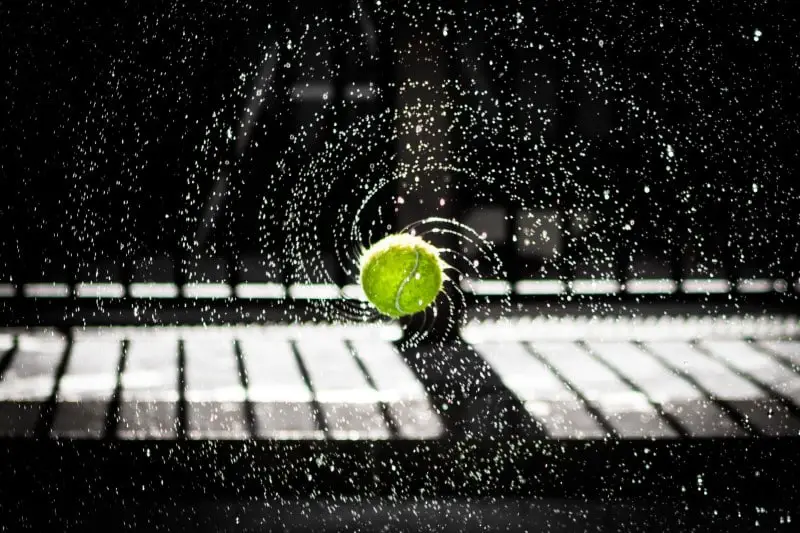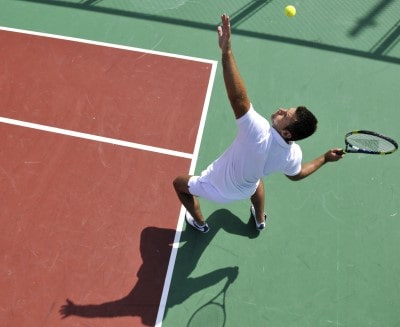While playing tennis, the weather conditions will never always be ideal. Rain can quickly put an end to your tennis matches and send you packing to wait for better weather. However, what happens when a tennis ball falls into a puddle of water on the court? In this article, we will answer if tennis balls are waterproof.
The outside of a tennis ball is not waterproof and will soak up water on its surface. However, the inside of a tennis ball is waterproof. It is tightly sealed so no water can enter and is filled with pressurized air, which results in the tennis ball floating on water.
While a tennis ball’s surface isn’t waterproof, there are water-resistant tennis balls that soak up less water and have reduced drying time. To learn more about the effects of water on tennis balls and water-resistant tennis balls, continue reading.

Are Tennis Balls Waterproof?
Tennis and rain usually don’t mix well. The tennis racket’s strings, the tennis balls, and tennis courts are all significantly affected by the rain.
Not to mention the potential injuries you may sustain by playing tennis in a wet environment that is a possible slip hazard. The correct response in most cases is to forego the tennis match until the weather is cleared up, and your equipment can’t get wet.
However, there may be some instances where your tennis ball will get wet without it raining heavily. Tennis balls are not considered to be waterproof and will soak up water on its felt material surface. If the ball gets hit into a shallow puddle, you can quickly get the ball back into working condition by hitting the ball on the ground a few times.
You will need to be more cautious in very wet environments where the ball is soaked by water.
Because the tennis ball soaks up water quickly, it will become heavier and lose its bounce if it gets very wet, potentially deforming the ball’s shape. When you notice that the tennis ball is getting harder to hit and hurting your elbow, it is time to switch it out for another tennis ball.
While tennis balls are not fully waterproof, there are alternative products that do a better job of repelling water than your standard tennis ball. These products have a protective spray on the surface and are heavier, which allows the ball to throw off the water when they are hit.
Water-Resistant vs Waterproof
Some tennis ball manufacturers will label their products as waterproof, however—no tennis ball will be 100% waterproof. Waterproof is defined as “impervious to water,” which isn’t the case for any tennis ball available today. If any tennis ball lands in a puddle of water, it will not be dry in an instant, and you will have to wait for the ball to dry before putting it back into play.
These waterproof tennis balls should be considered to be water-resistant and will soak up less water with a faster drying time than a standard ball. Tennis balls like the Tretorn MicroX are harder and have an easier time repelling the water from its surface.
You will still notice the effects of water while you are playing because it will have a hard time bouncing on the court. These tennis balls should only be used while it is wet, as regular tennis balls are more comfortable to hit and are more accurate in dry environments.
What is Hydroguard?
The English tennis ball manufacturer Slazenger has developed a water-resistant cloth technology for their tennis products. This technology is one of the most effective water resistance technologies on the market. It has been tested by the manufacturer to reduce water by up to 70% more than your average tennis ball.
These tennis balls will maintain their performance longer but are not a complete solution to the water problem. You will still notice the adverse effects of water on the tennis ball when playing with these Hydroguard tennis balls.
Under heavy rain conditions, no tennis ball will retain its performance and not soak up excess water from the court.
Will Rain Ruin a Tennis Ball?
Is rain a recipe for disaster for your tennis balls? Fortunately, the rain will not ruin a tennis ball, but it isn’t usable when it is wet. You will need to wait for the tennis ball to dry before you attempt to use it again.
There are ways to speed up the drying process, getting the tennis balls back into working condition in a flash.
Some of the quickest and easiest ways to dry a tennis ball are:
- Putting them in a dryer
- Using a towel
- Using a hairdryer
How to Use a Dryer to Dry Tennis Balls
One of the easiest ways to dry a wet tennis ball is by putting them into the dryer. Tennis balls are also used to soften clothing, so this is a great way to get two things accomplished from a single dryer cycle.
Be sure that you only use a low-heat setting while you are drying the tennis balls to avoid any heat damage to the fibers. Also, be sure that you wipe the tennis ball’s surface to ensure it is clean before mixing them with freshly washed clothes.
Using a Towel to Dry Tennis Balls
Using a towel is a quick way to dry a tennis ball and can be done from anywhere. Keep a towel in your car in case one of your tennis balls gets wet, and you need a quick way to get them back to normal.
After a few minutes, you will notice that your tennis ball is no longer soaked and bounced normally. This method typically won’t thoroughly dry the tennis ball, but it will make them playable again.
Using a Hairdryer to Dry Tennis Balls
Like a standard clothing dryer, this method is an easy way to dry the tennis balls quickly. Put the hairdryer on the cool air setting, so you do not damage or burn the tennis ball’s felt surface.
Aim the hairdryer at the tennis ball, and after a few minutes, you will notice the tennis ball is almost thoroughly dried.
Do Water Repellant Sprays Work?
To waterproof their tennis balls, some tennis players will spray the surface with general water-repellant sprays like Scotch Guard or NeverWet. Unfortunately, these sprays do not fully waterproof a tennis ball. These sprays merely speed up the drying process slightly and will not protect the tennis ball from being affected by water.
It doesn’t hurt to spray these water-repellant sprays onto the tennis ball’s surface, just don’t expect a miracle cure. It is a better idea to purchase a harder tennis ball better designed for wet environments like the Tretorn MicroX or Slazenger Hydroguard tennis balls.
Conclusion
There is a good reason why people don’t play tennis in the rain very often. Water will damage all parts of the tennis-playing process, from the tennis rackets to tennis courts. It is a good idea not to play tennis in wet environments that can get tennis balls wet.
The tennis ball’s design with its felt material is not waterproof and will quickly soak up water on the court while you are playing and will start to affect how the ball bounces. The effects of water are typically noticed in very wet environments, and a ball bouncing into a puddle will not ruin it.
If you are determined to play tennis in a wet environment, bring a towel and use a tennis ball labeled as waterproof. These waterproof tennis balls, while not fully waterproof—they do a better job at repelling water.


